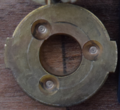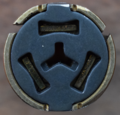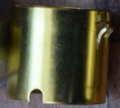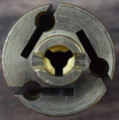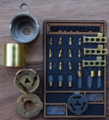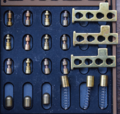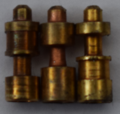FAB NZS3
FAB NZS3
| FAB NZS3 | |
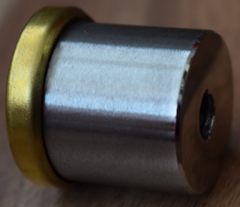 | |
| Name | FAB NZS3 |
|---|---|
| Manufacturer | Fab |
| Lock Type | Cylinder |
| Lock Design | Pin-tumbler |
| Patent | 255002 |
FAB NZS3 is a family of locks, that is completely different from the rest of FAB's production. The family contains the A version, that is to be used in place of a double euro lock (although a special security fitting is necessary), the B version for secondary door locks, C version for closets and E version for cars.
It belonged to a resistance class 3 and it had a security card to control unauthorized key copying.
Most probably due to its unusual form factor and its high price the lock didn't proliferate much and it doesn't seem to be produced anymore.
Principles of operation
All FAB NZS3 locks share the same core, just the outside housing differs. The locking mechanism is quite unusual - the core rotation is blocked by three massive pins, that rest in the dimples of the backplate. Each of those pins is supported by the sidebar, which can move towards the front of the lock when the correct key is inserted, allowing the blocking pins to clear the backplate dimples. Each of those sidebars is controlled by one blade of the key; each blade has four cuts and there are only three cut depths available. These cuts operate four pins; the pins are quite uncommon, as there are only key pins present in the lock. These pins protrude through the holes in the sidebar; each of those pins has a thin section at one of three heights - when all pins are lifted so the thin sections are at the depth of the sidebar, the sidebar can retract and allows operation of the lock.
The keyway is asymmetric, which together with protrusions on two of the key blades allows insertion and removal of the key only when its orientation is correct.
The core contains drill protection in the form of a metal sandwich crimped to the core face, but even with it the lock was only marketed as belonging to the resistance class 3.
Disassembly instructions
This lock is next to impossible to disassemble non-destructively. First of all, the crimped-on part holding the backplate needs to be removed, allowing removal of the backplate and the core itself from the protective housing. Then, the core sleeve is crimped to the core itself and only after it is removed, the core can be disassembled, although care must be taken not to catch/mangle springs by the crimped connection remnants.
Complete gutting (without removal of the backplate collar) can be seen in the video referenced below.
Vulnerabilities
The FAB NZS3 is vulnerable to one or more of the following:
Gallery
References



